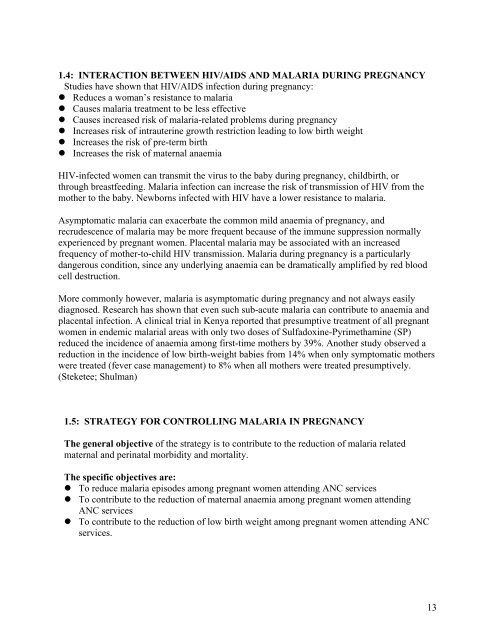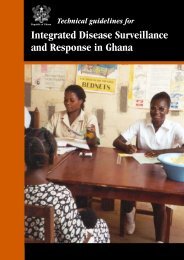Training Manual for Preventive Malaria - Ministry of Health
Training Manual for Preventive Malaria - Ministry of Health
Training Manual for Preventive Malaria - Ministry of Health
You also want an ePaper? Increase the reach of your titles
YUMPU automatically turns print PDFs into web optimized ePapers that Google loves.
1.4: INTERACTION BETWEEN HIV/AIDS AND MALARIA DURING PREGNANCY<br />
Studies have shown that HIV/AIDS infection during pregnancy:<br />
• Reduces a woman’s resistance to malaria<br />
• Causes malaria treatment to be less effective<br />
• Causes increased risk <strong>of</strong> malaria-related problems during pregnancy<br />
• Increases risk <strong>of</strong> intrauterine growth restriction leading to low birth weight<br />
• Increases the risk <strong>of</strong> pre-term birth<br />
• Increases the risk <strong>of</strong> maternal anaemia<br />
HIV-infected women can transmit the virus to the baby during pregnancy, childbirth, or<br />
through breastfeeding. <strong>Malaria</strong> infection can increase the risk <strong>of</strong> transmission <strong>of</strong> HIV from the<br />
mother to the baby. Newborns infected with HIV have a lower resistance to malaria.<br />
Asymptomatic malaria can exacerbate the common mild anaemia <strong>of</strong> pregnancy, and<br />
recrudescence <strong>of</strong> malaria may be more frequent because <strong>of</strong> the immune suppression normally<br />
experienced by pregnant women. Placental malaria may be associated with an increased<br />
frequency <strong>of</strong> mother-to-child HIV transmission. <strong>Malaria</strong> during pregnancy is a particularly<br />
dangerous condition, since any underlying anaemia can be dramatically amplified by red blood<br />
cell destruction.<br />
More commonly however, malaria is asymptomatic during pregnancy and not always easily<br />
diagnosed. Research has shown that even such sub-acute malaria can contribute to anaemia and<br />
placental infection. A clinical trial in Kenya reported that presumptive treatment <strong>of</strong> all pregnant<br />
women in endemic malarial areas with only two doses <strong>of</strong> Sulfadoxine-Pyrimethamine (SP)<br />
reduced the incidence <strong>of</strong> anaemia among first-time mothers by 39%. Another study observed a<br />
reduction in the incidence <strong>of</strong> low birth-weight babies from 14% when only symptomatic mothers<br />
were treated (fever case management) to 8% when all mothers were treated presumptively.<br />
( Steketee; Shulman)<br />
1.5: STRATEGY FOR CONTROLLING MALARIA IN PREGNANCY<br />
The general objective <strong>of</strong> the strategy is to contribute to the reduction <strong>of</strong> malaria related<br />
maternal and perinatal morbidity and mortality.<br />
The specific objectives are:<br />
• To reduce malaria episodes among pregnant women attending ANC services<br />
• To contribute to the reduction <strong>of</strong> maternal anaemia among pregnant women attending<br />
ANC services<br />
• To contribute to the reduction <strong>of</strong> low birth weight among pregnant women attending ANC<br />
services.<br />
13















